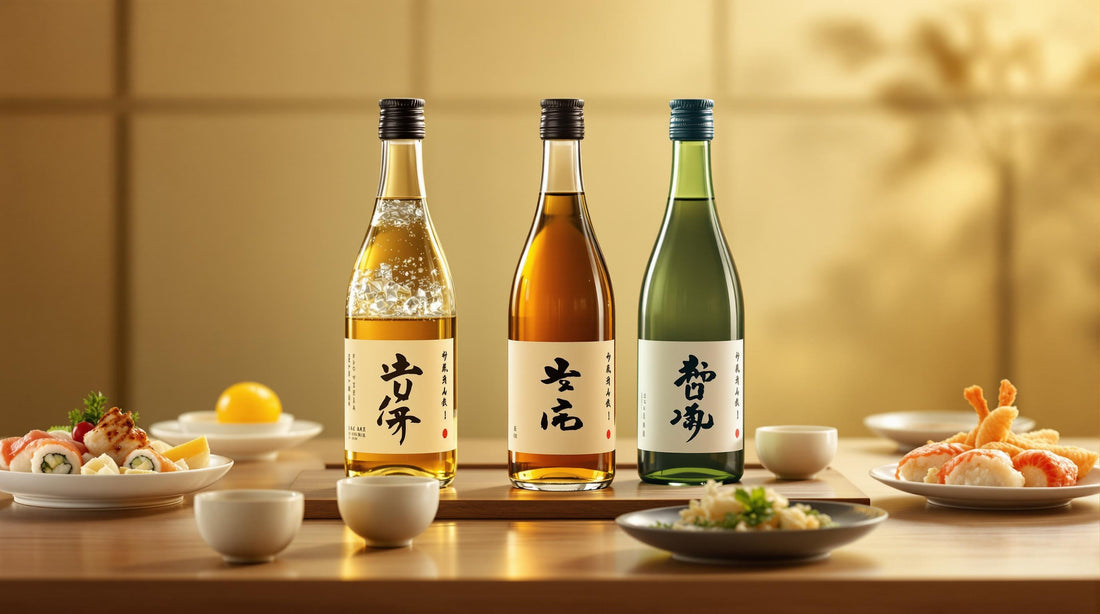
How Temperature Affects Sake Flavor
Share
The temperature at which you serve sake can completely change its flavor, aroma, and texture. Here's what you need to know:
- Chilled Sake (5°C - 15°C): Crisp, light, and refreshing. Best for delicate types like Ginjo and Daiginjo.
- Room Temperature Sake (20°C - 25°C): Balanced and nuanced. Ideal for most sake varieties.
- Warm Sake (35°C - 40°C): Sweetness, umami, and alcohol notes become more pronounced. Great for richer styles like Junmai, Kimoto, and Yamahai.
Temperature also affects acidity and alcohol perception. Chilling reduces intensity, while warming enhances sweetness and richness. For the best experience, adjust the temperature based on the sake style and your personal taste. Experimentation is key to discovering your preferred flavor profile.
Sake: Hot or Cold? Everything You Need to Know
Choosing the Right Temperature for Sake Types
Understanding how temperature affects sake flavor is just the beginning. Let’s dive into how to select the best serving temperature for various sake styles.
Typical Sake Serving Temperatures
Each type of sake shines at specific temperatures, depending on its style and flavor profile. For example, delicate ginjo and daiginjo sake are best enjoyed chilled to highlight their floral and fruity notes. On the other hand, richer varieties like junmai and yamahai develop deeper flavors when served warm [2]. Here's a quick guide to matching sake types with serving temperatures:
- Very Cold (5°C - 10°C): Premium daiginjo, light ginjo
- Chilled (10°C - 15°C): Most ginjo, fresh junmai
- Room Temperature (20°C - 25°C): Full-bodied junmai, honjozo
- Warm (35°C - 40°C): Robust kimoto, yamahai
Using Sake Labels for Temperature Guidance
Sake bottles often include serving temperature recommendations. Look for symbols, tasting notes, or traditional terms like "kan" (warm) and "rei" (chilled) to guide your choice [3].
"Heating sake changes how the tongue perceives certain flavors. Sweetness and umami become more pronounced at nearly body temperature." - Japan Sake and Shochu Makers Association [3]
Start with the recommended temperature on the label and adjust to suit your taste. For example, aged sake (koshu) often reveals its intricate flavors and aromas best at room temperature, allowing you to fully experience its complexity.
Experimenting with different temperatures can unlock unexpected flavors, making each sip a discovery. Once you know the ideal temperature for your sake, the next step is mastering how to achieve it.
sbb-itb-d9fb1bc
Methods for Adjusting Sake Temperature
Adjusting the temperature of sake can bring out its best flavors, helping you enjoy its distinct characteristics. Whether you're warming or chilling, the key is to highlight the sake's natural taste without overwhelming its delicate balance.
Warming Sake Safely
To warm sake, use a hot water bath (yukan) at 45-50°C (113-122°F), ensuring the bottle's neck stays above the water. Stick to temperatures under 40°C (104°F) to maintain the flavor integrity. Warming times depend on the type of sake but usually fall between 3-6 minutes.
| Temperature Range | Ideal For |
|---|---|
| 35°C (95°F) | Light junmai sakes |
| 37°C (98.6°F) | Rich, full-bodied junmai sakes |
| 40°C (104°F) | Robust kimoto or yamahai sakes |
Chilling Sake Effectively
For chilled sake, you can refrigerate it for slow cooling or use an ice bath for faster results. Premium types like daiginjo are best served at 5-10°C (41-50°F). A thermometer can help ensure you don’t over-chill, as this can dull the sake's subtle nuances.
To discover the ideal temperature for a specific sake, try sampling small portions at varying temperatures. Sakes with higher acidity often shine at slightly warmer temperatures, while those with lower acidity hold up well when chilled.
Fine-tuning the temperature is just the start - pairing sake with the right dishes can elevate the entire tasting experience.
Sake and Food Pairing by Temperature
The temperature of sake plays a key role in how it pairs with food, creating combinations that elevate the overall dining experience. Matching the right sake temperature with the right dish not only enhances flavors but also allows you to explore sake's range in new ways.
Warm Sake with Rich, Comforting Dishes
Warm sake, typically served between 20°C and 29°C, brings out its umami and sweetness, making it a great match for bold, hearty meals. This temperature range is perfect for dishes with deep, savory flavors, especially those enjoyed during colder months.
| Dish Type | Ideal Sake Temperature | Why It Works |
|---|---|---|
| Grilled Meats | 25-29°C | Highlights umami and complements smoky notes |
| Winter Stews | 20-25°C | Sweetness balances the richness of broths |
| Braised Dishes | 22-27°C | Aromatics align with slow-cooked flavors |
Warm sake softens acidity and emphasizes sweetness, making it a natural choice for meals that are rich, savory, and comforting.
Chilled Sake with Light, Fresh Meals
Chilled sake, served between 10°C and 15°C, maintains its crisp and delicate profile, offering a refreshing contrast to lighter dishes. This cooler temperature enhances subtle flavors while keeping the sake's freshness intact.
Here are a few pairing suggestions for chilled sake and lighter meals:
| Dish Type | Suggested Temperature | Pairing Advantage |
|---|---|---|
| Sashimi | 10-12°C | Preserves the delicate taste of fresh fish |
| Summer Salads | 12-15°C | Complements the crunch and freshness of veggies |
| Tempura | 13-15°C | Balances the light, crispy texture |
The lower temperature enhances the sake's clean and refreshing qualities, making it an excellent match for dishes that are subtle and delicate [1].
Conclusion
How Temperature Shapes Sake's Flavor
The temperature at which sake is served can dramatically change its flavor profile. Chilled sake brings out crisp and delicate notes, while warmed sake highlights its rich umami flavors. By understanding these effects, you can elevate your enjoyment of sake, tailoring each sip to suit your taste and the occasion.
Mastering the role of temperature in sake service also helps you unlock new ways to enjoy this drink. Whether pairing it with a meal or trying out different serving styles, temperature control allows you to experience the full range of what sake has to offer.
Explore Sake with The Sake Company

Curious to experiment with sake and serving temperatures? The Sake Company provides discovery boxes and resources to guide you. Their curated selections include handy temperature guides, making it easier to explore the many styles of sake across seasons and occasions.
Check out The Sake Company to start exploring the world of sake and find the perfect fit for your palate.
